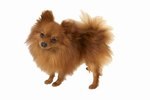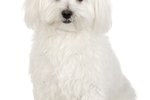
Your chinchilla's soft, beautiful fur is the reason the species were practically wiped out in their native South American habitat. Thankfully, yours doesn't have to worry about you doing anything with his pelt besides petting. The thickness and density of his fur make him a pleasure to pet.
Fur Density
Your chinchilla's extreme fur density makes his coat so soft. Your pet's fur boasts the highest density of any land mammal. It contains more than 20,000 hairs per square centimeter. For most mammals, one hair grows from each follicle. But more than 50 hairs come out of each chinchilla follicles. That's an extraordinary amount of hair for a rodent that weighs little more than a pound when full-grown. The fur density also contributes to your pet's lack of odor. A smelly chinchilla is usually a sick chinchilla.
Fur and Handling
The classic, wild chinchilla coat consists of dense blue-gray hairs, but breeders have developed other shades, including black, white, silver and beige. Naturally high-strung animals, chinchillas need gentle handling from birth in order to make good pets. They're fast and can jump out of your grasp before you know it. Those quick moves can results in fur slip -- whereby you are no longer holding a chinchilla but you do have a big hunk of fur in your hands. The best way to avoid this is by holding your pet in one hand while his body rests on your opposite forearm and against your chest.
Dust-Bathing
Because his fur is so dense, water won't clean it. Your pet requires regular dust baths to clean his coat and keep it in healthy condition. Use special chinchilla dust bath formulas, available at pet stores. Use a large bowl or container for the dust so your pet can roll around in it. Put it in his cage several times a week for him to clean himself but don't allow him access to the dust all the time -- doing so could mean skin-drying and eye irritations, as well as more dust in your house.
Care and Feeding
The keys to keeping your chinchilla healthy and his coat in top condition are proper care and feeding. Because his teeth grow continuously, your chin requires a constant supply of timothy or grass hay to wear them down and keep his gastrointestinal system moving. He needs clean water available all the time. Because he loves to jump and climb, provide him a tall cage with suitable perches and ledges. Let him out for supervised play every day in a chinchilla-proofed room. Because chinchillas are very sensitive to heat, you'll need to keep the cage out of direct sunlight.
References
Photo Credits
-
Creatas/Creatas/Getty Images
Writer Bio
Jane Meggitt has been a writer for more than 20 years. In addition to reporting for a major newspaper chain, she has been published in "Horse News," "Suburban Classic," "Hoof Beats," "Equine Journal" and other publications. She has a Bachelor of Arts in English from New York University and an Associate of Arts from the American Academy of Dramatics Arts, New York City.




